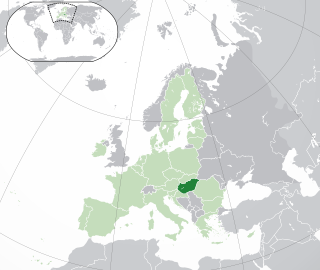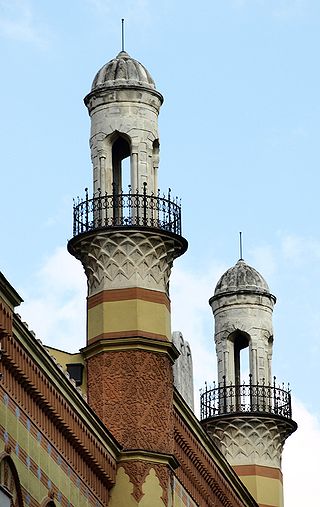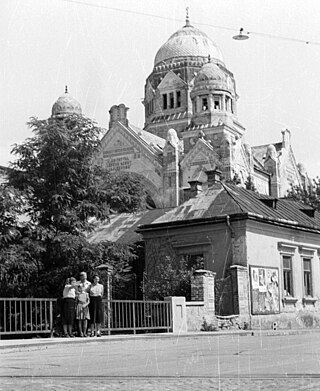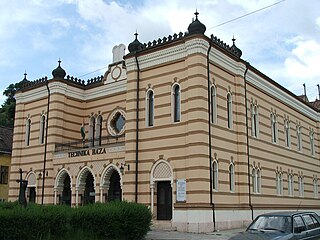
The Budapest Ghetto was a Nazi ghetto set up in Budapest, Hungary, where Jews were forced to relocate by a decree of the Government of National Unity led by the fascist Arrow Cross Party during the final stages of World War II. The ghetto existed from November 29, 1944, to January 17, 1945.

Kiskörút or Small Boulevard is a major thoroughfare in Budapest. It forms an incomplete semicircle between Deák Square and Fővám Square. It is the border of the southern part of District 5, the innermost district of Pest. As opposed to Nagykörút, it only touches the Danube at its southern end.

The history of the Jews in Hungary dates back to at least the Kingdom of Hungary, with some records even predating the Hungarian conquest of the Carpathian Basin in 895 CE by over 600 years. Written sources prove that Jewish communities lived in the medieval Kingdom of Hungary and it is even assumed that several sections of the heterogeneous Hungarian tribes practiced Judaism. Jewish officials served the king during the early 13th century reign of Andrew II. From the second part of the 13th century, the general religious tolerance decreased and Hungary's policies became similar to the treatment of the Jewish population in Western Europe.

Novi Sad Synagogue is one of many cultural institutions in Novi Sad, Serbia, in the capital of Serbian the province of Vojvodina. Located on Jevrejska (Jewish) Street, in the city center, the synagogue has been recognized as a historic landmark. It served the local Neolog congregation.

The Dohány Street Synagogue, also known as the Great Synagogue or Tabakgasse Synagogue, is a historical building in Erzsébetváros, the 7th district of Budapest, Hungary. It is the largest synagogue in Europe, seating 3,000 people and is a centre of Neolog Judaism.

Füzesgyarmat is a town in Békés county, in the Southern Great Plain region of south-east Hungary.

Piricse is a village in Szabolcs-Szatmár-Bereg county, in the Northern Great Plain region of eastern Hungary.

The Shoes on the Danube Bank is a memorial erected on 16 April 2005, in Budapest, Hungary. Conceived by film director Can Togay, he created it on the east bank of the Danube River with sculptor Gyula Pauer to honour the Jews who were massacred by fascist Hungarian militia belonging to the Arrow Cross Party in Budapest during the Second World War. They were ordered to take off their shoes, and were shot at the edge of the water so that their bodies fell into the river and were carried away. The memorial represents their shoes left behind on the bank.

Slomó Köves is a leading Orthodox rabbi and chief rabbi of EMIH an affiliate of Chabad-Lubavitch in Hungary which is led by rabbi Baruch Oberlander.

The Rumbach Street synagogue is located in Belváros, the inner city of the historical old town of Pest, in the eastern section of Budapest. The synagogue in Rumbach Street was built in 1872 to the design of the Viennese architect Otto Wagner. Intentionally meant to serve the members of the Neológ community of Pest, its construction coincided with the Schism in Hungarian Jewry of 1869, and it became the home of the more conservative Status Quo faction.

The Kozma Street Cemetery is the biggest Jewish cemetery of Budapest, Hungary. It is located next to the New Public Cemetery (Újköztemető).

The Jakab and Komor Square Synagogue in Subotica is a Hungarian Art Nouveau synagogue in Subotica, Serbia. It is the second largest synagogue in Europe after the Dohány Street Synagogue in Budapest. It was built in 1901–1902 during the administration of the Kingdom of Hungary, according to the plans of Marcell Komor and Dezső Jakab replacing a smaller and less elaborate synagogue. It is one of the finest surviving pieces of religious architecture in the art nouveau style. It served the local Neolog community.

The Újpest Synagogue is a Neolog Judaism synagogue in Újpest, a district of Budapest, Hungary. The Romantic-style edifice was built in 1866 and holds 1,000 seats. Rabbi Sander Rosenberg from Arad officiated at the opening ceremony. Its establishment was a "great holiday" for the Jews and Christians of Újpest. It lies in 8 Gergely Berzeviczy Street about five minutes from Újpest-Városkapu metro station.

Dezső Kanizsai was a Hungarian audiologist and educator of deaf children. Kanizsai was born in Cífer in 1886. He taught at the Jewish Institute for the Deaf in Budapest starting in 1907. During the interwar period he developed and publicized his own teaching program. His school on Mexico Square became a social club for the deaf Jews of Budapest.

The Holocaust Memorial Center is a renovated synagogue that dates back to the 1920s and serves as a memorial and museum for and about Hungarian Jews that were murdered in the Holocaust. While largely focused on Jews, the museum also mentions the discrimination and killings of Romani, of homosexuals, and of the disabled. It is located in Budapest, Hungary.

The Páva Street Synagogue is a large-scale Hungarian synagogue building designed by Lipót Baumhorn in the first half of the 20th century, and nowadays it houses the Holocaust Memorial Center and the Budapest Synagogue.

The Eger Synagogue was a Jewish Synagogue in Eger, Hungary.

The Esztergom Synagogue is a building located in the town of Esztergom, Hungary. It was built in 1859, renovated in 1888, and severely damaged by a bombing during World War II. Since almost all Jewish people in the town were deported during the Holocaust and Communists subsequently gained control of the country, it has not been used for religious purposes since the 1940s.




















